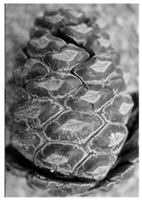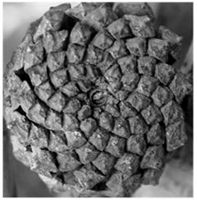Plant Patterns and Phyllotaxis
October 26, 2004

Figure 1. Families of spirals on a cactus: three clockwise (dark), five counterclockwise (light), and eight slightly clockwise (dark).
The spiral patterns observed in sunflowers, pine cones, cacti, and various other plants often, although not always, encode the Fibonacci sequence. In the cactus shown in Figure 1, for example, the phylla (stickers, leaves, florets)---the maxima of the bumps (primordia) on the deformed surface-all lie on three families of spirals. One family has three arms going clockwise, another has five arms going counterclockwise, and a third family has eight spirals that are almost radial but still slightly clockwise. These plant surfaces are also tiled in irregular polygons. Figure 2 shows ribs on a saguaro cactus, hexagonal shapes on a Matucana cactus, and parallelograms on a pine cone.
Alan Newell and P.D. Shipman, as described by Newell in his John von Neumann lecture at the 2004 SIAM Annual Meeting, have sought to understand the formation of patterns in plants and plant phyllotaxis in the same way researchers understand various other patterns: sand ripples on desert dunes or gently sloping beaches, stripes on the coats of tigers, hexagonally placed spots on leopards, the fingerprints encoded on the epidermal ridges of our fingers.
There is no special, intricate design process. Instead, such patterns arise when spatially extended, dissipative systems are subjected to some outside stress.
When the stress is big enough, the uniform state becomes unstable and certain shapes and configurations are preferentially amplified. They compete for domination, and, eventually, a winning shape emerges.
In the case of plants, Paul Green and colleagues at Stanford have suggested that the origin of the external stress is differential growth near the tip of the plant's shoot, which causes an annular region of the plant's tunica (its hardened skin) to undergo compressive stresses. After an analytical and numerical investigation of the behaviors and structures of certain coefficients that arise, Shipman and Newell conclude that the winning configurations-in this case those that minimize the elastic energy of the compressed annular zone-are in close harmony with what is observed in nature.
Three key ideas underlie this work. The first is that, since the circumferential stress in the annulus is greater than the radial stress, the initial buckling pattern will tend to be a wedge-like deformation, with radial crests dividing the annular ring into 2N equal slices. The slice length is independent of the ring radius, so that as the latter increases, the number of crests will increase to 2N + 1.
The second key idea is that this configuration is unstable to a deformation involving two spiral shapes, each with roughly half the number of crests, one running clockwise and the other counterclockwise. The deformed surface that minimizes the energy is a sum of the three basic configurations with N clockwise spirals, N counterclockwise spirals, and 2N wedges. As the radius of
the annular ring grows to accommodate 2N + 1 wedges, the (N, N, 2N) triad makes a transition (undergoes, in physics parlance, a first-order phase transition) to an (N, N + 1, 2N + 1) triad. The occurrence of strongly interacting triads of fundamental configurations is not surprising: Superpositions of exactly this type give rise to the hexagonal planforms observed in sunspots, counterpropagating laser beams, and some geological formations.
The third idea is that, as this pattern leaves the annular region of compressive stress (the plant's tunica is replaced at a slightly faster rate than the plant grows), it biases the outcome of the new buckling pattern. In addition to the strong coupling N + (N + 1) = 2N + 1, two other binary couplings are possible: N + (2N + 1) = 3N + 1 and (N + 1) + (2N + 1) = 3N + 2. For reasons Shipman and Newell have explained, the latter is the winner. The new energy-minimizing deformation is one that superposes four fundamental shapes, two overlapping triads N, N + 1, 2N + 1, 3N + 2, in which the magnitudes of the central two are slightly greater than those of N and 3N + 2. This gives rise to the parallelograms seen, for example, on pine cones.
The process continues. As the plant continues to grow, the winning deformation is a superposition of four to five modes in the Fibonacci sequence (N, N + 1, 2N + 1, 3N + 2, . . .) from which the first N modes have been deleted. Under what circumstances is this sequence not followed? It turns out that if the curvature of the annular region (think of a section cut out of a bowl) becomes small (the bowl flattens out), the binary coupling is small and the energy-minimizing configurations tend to be wedge-like structures (as in the saguaro cactus) in which new crests are added one at a time as the plant grows. Dislocations, points at which two rib crests merge, connect the N + 1- and N-wedge patterns.
 a
a
 b
b
 c
c
Figure 2. Ridges on a saguaro cactus (a), hexagons on a cactus of the genus Matucana (b), and parallelograms on a pine cone (c).
The main ideas briefly described here have been presented in Physical Review Letters (Phys. Rev. Lett., 92 :168102 (2004)). The full story is presently under review; a preprint can be obtained at http://math.arizona.edu/~pship/. The work has been supported by NSF grant DMS 0202440 and NSF VIGRE grant 9977116.

